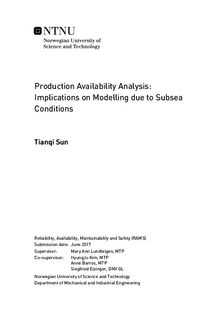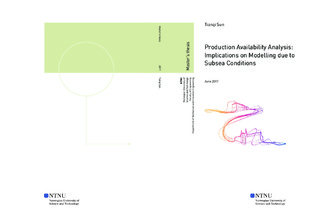| dc.description.abstract | Subsea production and processing systems have become a hot topic among research institutes and industries. While highlighting the advantages on production and economy, the reliability issues show a different picture with limited access, difficulty of maintenance and possibly lower availability. The influence of these issues on the system performance is thus to be studied, to evaluate the benefit of subsea systems.
A literature review was carried out to prepare the background knowledge of the subsea system and its features. The main elements in subsea systems were introduced. Since the study case was about implementing a subsea separator, a more detailed introduction on subsea separation was provided. The drivers and challenges for subsea were also discussed, together with considerations for reliability modeling.
Production availability analysis was selected as the approach for analysis. By conducting such an analysis, the system performance can be predicted and the critical components can be identified for system optimization.
Two different types of approaches, the analytical approach and the simulation approach, were discussed in this thesis. The analytical approaches have restricted use and provide less precise results, but require less effort. The simulation approaches are more flexible and can provide more detailed predictions, but are rather time and cost consuming, and a solid mathematical and programming basis is often needed. A set of software tools were developed to simplify this approach. Since this thesis was done in collaboration with DNV GL, ExtendSim is suggested for the case study. The basic principles of Discrete Event Simulation, especially of ExtendSim, was introduced for a better understanding of how simulation is performed in these tools.
After all preparations were ready, a case study was carried out to demonstrate the analysis process. Two difference cases, namely a reference case (with all separation on FPSO) and a subsea case (with the use of subsea separator), were modeled in ExtendSim based on a library from DNV GL. The modeling process was demonstrated in detail. The production availability and loss contributors for the two cases were derived from simulations.
A discussion was then carried out on the model and the potential use of the results. Recommendations for future work were included at the end of this thesis. | en |

